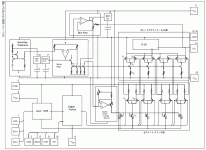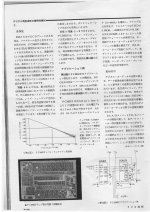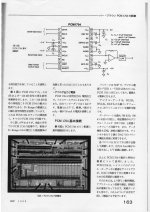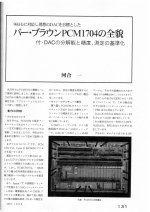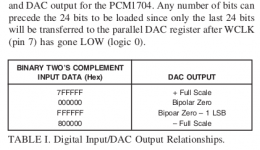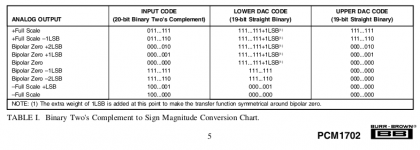" This is not the end, not even the beginning of the end, but it is the end of the beginning "
Sir Winston Churchill 1943
Derek, to be pedantic, this quote comes from a speech made by Winston Churchill at the Lord Mayor's Luncheon on 10th November 1942. It references the defeat of Rommel at El Alamein.
Personally, I think there are many better Churchill quotes, especially in the context of this forum, I like;
“Success is not final, failure is not fatal: it is the courage to continue that counts.”
Anyway, enough off-topic digression.
Ray
ooops.... I wrote wrong, I meant the 1st option, single ladder network and single positive voltage reference.
In my opinion, the optimal would be a single R-2R ladder driven by trilevel (ref+, gnd, ref-) drivers, with two tracking references....
To be accurate you were not being pedantic...
You are simply stating that you prefer another quote....Sorry for not asking your opinion.....
Is it ok with you I still choose my own quote...
Please don't be even more pedantic and list all the references you feel I should add....
Maybe you want to run my business for me and bring up my kids too ....PM if you wish to learn more about attempting to be pedantic....
Apologies to the group but notty boy's error does need correcting....
If you were being pedantic you would have been able to point out an error in my quote. My quote is accurate.... There is no error.Derek, to be pedantic, this quote comes from a speech made by Winston Churchill at the Lord Mayor's Luncheon on 10th November 1942. It references the defeat of Rommel at El Alamein.
Personally, I think there are many better Churchill quotes, especially in the context of this forum, I like;
“Success is not final, failure is not fatal: it is the courage to continue that counts.”
Anyway, enough off-topic digression.
Ray
You are simply stating that you prefer another quote....Sorry for not asking your opinion.....
Is it ok with you I still choose my own quote...
Please don't be even more pedantic and list all the references you feel I should add....
Maybe you want to run my business for me and bring up my kids too ....PM if you wish to learn more about attempting to be pedantic....
Apologies to the group but notty boy's error does need correcting....
Last edited:
If you were being pedantic you would have been able to point out an error in my quote. My quote is accurate.... There is no error.
You are simply stating that you prefer another quote....Sorry for not asking your opinion.....
Is it ok with you I still choose my own quote...
Please don't be even more pedantic and list all the references you feel I should add....
Maybe you want to run my business for me and bring up my kids too ....PM if you wish to learn more about attempting to be pedantic....
Apologies to the group but notty boy's error does need correcting....
Well, to me 1942 is a different year to 1943 but hey ho.
Let's move on, sorry to have upset you.
Ray
Andrea,
No, BB's sign magnitude DACs have one refference and two ladders,in fact,two segmented 23bit (in 1704) DACs(consists of current sources and a ladder) plus one extra LSB.
BB's ladder runs in current mode ,so two ladders output can be easily combined (done in the IC).
Technics had sold CD players having sign magnitude with two PCM56P.
It needed to adjust the gains of upper and lower half.
Reading the datasheet seems that BB implements the 2nd option "The two DACs share a common reference, and a common R-2R ladder ...".
In the PCM1704 they used 2 voltage rails, positive and negative, but one reference only with a servo to ensure the voltage tracking, and a single ladder network. So I presume they switch the R2R ladder between positive and negative depending on the sign bit.
No, BB's sign magnitude DACs have one refference and two ladders,in fact,two segmented 23bit (in 1704) DACs(consists of current sources and a ladder) plus one extra LSB.
BB's ladder runs in current mode ,so two ladders output can be easily combined (done in the IC).
Technics had sold CD players having sign magnitude with two PCM56P.
It needed to adjust the gains of upper and lower half.
Andrea,
No, BB's sign magnitude DACs have one refference and two ladders,in fact,two segmented 23bit (in 1704) DACs(consists of current sources and a ladder) plus one extra LSB.
BB's ladder runs in current mode ,so two ladders output can be easily combined (done in the IC).
Technics had sold CD players having sign magnitude with two PCM56P.
It needed to adjust the gains of upper and lower half.
Actually, looking at the diagram in the datasheet there are 2 DACs (I know it's a current output DAC).
But in the paragraph "Theory of operation - Sign-Magnitude Architecture" at page no. 6 they say " The two DACs share a common reference,and a common R-2R ladder....", so I presumed a single ladder network, that seems in contrast against the diagram.
Andrea,
No, BB's sign magnitude DACs have one refference and two ladders,in fact,two segmented 23bit (in 1704) DACs(consists of current sources and a ladder) plus one extra LSB.
BB's ladder runs in current mode ,so two ladders output can be easily combined (done in the IC).
Technics had sold CD players having sign magnitude with two PCM56P.
It needed to adjust the gains of upper and lower half.
To me it looks like the 1704 has one R-2R ladder shared between the two DAC sections, that's what the datasheet says, don't know exactly how, even this BB drawing I found is not that clear....
Attachments
To me it looks like the 1704 has one R-2R ladder shared between the two DAC sections, that's what the datasheet says, don't know exactly how, even this BB drawing I found is not that clear....
My datasheet does not show this detailed diagram, where did you find it?
Anyway the diagram you posted confirm the explanation in the "Sign-Magnitude Architecture" paragraph.
Did you understand how they switch the ladder from +Vcc and -Vcc?
My datasheet does not show this detailed diagram, where did you find it?
Anyway the diagram you posted confirm the explanation in the "Sign-Magnitude Architecture" paragraph.
Did you understand how they switch the ladder from +Vcc and -Vcc?
I found like pcm1704 drawing on the net, don't remember where....
But as I said, it's not clear to me how it actually work, could be some offset current involved.
The diagram is from a Japanese app note on the PCM1704. It has been posted on diyaudio before.
See http://www.diyaudio.com/forums/digi...on-about-de-coupling-capacitor-pcm1704-3.html
I'm currently running some tests on PCM1704 absolute linearity and harmonic distortions.
Børge
See http://www.diyaudio.com/forums/digi...on-about-de-coupling-capacitor-pcm1704-3.html
I'm currently running some tests on PCM1704 absolute linearity and harmonic distortions.
Børge

There is no such description on japanese datasheets of pcm63,1702,1704 or ANJ1082,ANJ1092! I did not know that.
Thanks Andrea, Søren.
So... I think each nodes of R-2R is feeded from two current sources. One is lower DAC's, another one is upper DAC's.
It matchs the diagram Søren posted, isnt it?
I have some articles copied from japanese audio magazine and there is die photographs of PCM63 and PCM1704.
I will scan and post them later, though they are not good quality copy.
Attached is an AES paper titled "20bit Colinear Dac - A solution to low level problems" which discusses the PCM63 architecture. Given the structure is similar to the PCM1704 the information might be of interest.
I've had to split the file to get around the forum size limit.
I've had to split the file to get around the forum size limit.
Attachments
Last edited:
- Home
- Vendor's Bazaar
- Reference DAC Module - Discrete R-2R Sign Magnitude 24 bit 384 KHz
